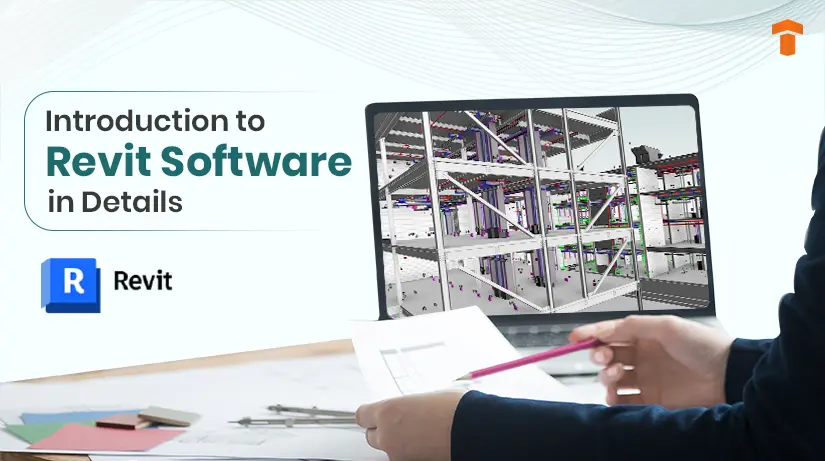Introduction to Revit Software in Detail
Nov 08, 2024
Category: Software & Tools
Admin

A professional in the AEC industry must possess knowledge and skills about Revit software. It is a top choice for architects, civil engineers, structural engineers, landscape designers, and contractors.
Numerous technologies are available to create building designs and modeling. However, Autodesk Revit is the most used Building Information Modeling (BIM) software today with a market share of 39.91%.
In this write-up, we will explore what is revit software, its benefits, revit plugins, its uses and more.
What is Revit Software?
Revit is one of the most popular software programs, and it has caused a paradigm shift in the AEC industry. Engineers, architects, and construction professionals use this Autodesk invention to design, document, and collaborate on building projects conveniently.
It is a revolutionary BIM (Building Information Modeling) tool that empowers users to create intricate 3D models of buildings and structures.
However, Revit’s use goes beyond modeling through the integration of key project information such as dimensions, schedules, materials, and costs into the model. Hence, team members can collaborate seamlessly due to swift model updates.
Benefits of Revit
Component-Based Family
In Revit, every project revolves around standard terms such as elements, parameters and families, etc. You can assign dimensions and properties to create a family. Also, Revit software allows you to use the components from other manufacturers.
Accuracy of Document
Parametric modeling makes integration with project documents, including specifications, easy. Architecture design service firms leverage the on-time generation of correct information accessible to collaborators and clients to improve cost and time efficiency.
Energy-Efficient and Sustainable
Revit’s innovative features encourage eco-friendly design development and implementation. Furthermore, conducting energy analysis with integrable cloud-based services and running simulations to save energy is possible.
Project Management Software Interoperability
This software can set up project schedules automatically to create a model. Additionally, Revit software helps you integrate with external project scheduling software. Your company can find this interoperability helpful while collaborating with an external BIM consultant.
Software Libraries
Revit offers an extensive library that helps you fulfill the requirements of various clients considering their guidelines and limitations. You do not have to stick to the default library components while working on different projects.
Revit Features in 2024
Revit 2024 is studded with noteworthy features. Here are some of the key enhancements in the 2024 version.
Toposolids
Elements such as floors, walls, roofs, ceilings, and curtain walls were referred to as system families in the previous version of Revit. Topography has distinct options and capabilities, hence it wasn’t considered a system family.
However, in the 2024 version of Revit, the developers have added Toposolids, which use the capabilities of system families to boost the power and versatility of Topography.
Textures Visual Style
Revit has introduced a fresh visual style known as Textures. It offers a unique blend of simple consistent colors and realism. This style is not limited to basic colors and it provides a nuanced visual experience through applying images to materials in the appearance tab.
Search in Project Browser
Revit’s project browser consists of a search tab that lets you navigate to various tools easily. All you have to do is type the keyword and you can locate stuff without wasting time.
Enable Split with Gap for MEP
The latest version of Revit software has a tool called Split with Gap for MEP components. It comprises a wide array of elements like pipes, conduits, ducts, cable trays, straight segments of MEP fabrication ductwork, MEP fabrication containment, and MEP fabrication pipework.
It is an ideal improvement that puts the AEC experts on the right path to match the industry demands leveraging MEP drafting capabilities.
My Insights
My insights icon in Revit software enables the users to share positive or negative feedback. However, you may not use this feature immediately as the software may gather some initial usage data before offering access to this feature.
Best Revit Plugins or Add-ons
Guardian
Guardian app is a leading-edge solution to deal with the human factor in a complex BIM system. It is a Revit add-on that enables the users to create various custom warnings for particular actions like the deletion of an important file.
You have to fill in a password to perform all the actions mentioned above. Also, mapping elements and custom warnings are popular features.
Ideate Explorer
This Revit plugin called Ideate Explorer offers a myriad of features and its one particular feature works as the highlight of the add-on. The most noteworthy feature in the Ideate Explorer is ‘Warning Manager’.
You can get a quick overview of the project warnings such as geometry issues and walls overlapping, etc. You can color-code the warnings to set the priorities using this plugin.
Enscape
Enscape is a top-notch real-time rendering add-on that offers renders of existing models in 2D/3D. Also, it provides 360 panoramas of the models.
You can export Enscape models to Oculus Rift and HTC Vive headsets. This plugin can be used as a free trial and students as well as teachers can use it as it offers an educational license.
Rhino.Inside
You can use Rhino.Inside to integrate Revit software and Rhino with the addition of Grasshopper, which is a renowned 3D add-on for Rhino. AEC professionals use these capabilities to ensure higher flexibility and versatility while designing the model without losing Revit’s BIM capabilities.
This plugin also streamlines data transfer between Revit and Rhino. It also utilizes Grasshopper scripts to enhance parametric model design.
Dynamo
Dynamo is a popular Revit plugin as it offers extensive functionality. This add-on is an open-source platform that uses multiple coding languages to integrate BIM with computational design.
Performing behavior scripting and design, defining custom logic parameters, and automating certain tasks is done by seasoned professionals using Dynamo. This add-on has been added to the basic package of Revit since 2020, hence you don’t need to even install it.
| Read More: 10 Amazing Revit Plugins You Should Know in 2024
Applications of Revit Software
Designing a Building
Revit facilitates architects in designing buildings and 3D models. This software helps in the visualization of a project in 3D, creates intricate building designs, and in-depth construction drawings and documentation.
Structural Engineering
AEC professionals use Revit for structural engineering. This software encompasses tools for the creation of detailed models of structural elements like columns, walls, and beams.
These models assist engineers in the analysis of the structural performance of a building to ensure it complies with the safety standards.
MEP Engineering
Revit software plays a vital role in designing and improving Mechanical, Electrical, and Plumbing (MEP) models. This software has high-tech tools to design and model difficult MEP systems like electrical, plumbing, and HVAC systems.
Revit helps MEP engineers in properly aligning the MEP systems with building design.
Construction Management
AEC experts recommend the use of Revit for construction management. Construction managers can visualize the construction process and plan the course of construction.
This software from Autodesk is also helpful in the coordination of construction activities and passing the project-related information to stakeholders.
Facility Management
This tool also plays a significant role in facility management. Revit models offer substantial information to the facility manager which facilitates the efficient management of maintenance and operations of a building.
Why Should You Use Python for Revit Software?
Python is a widely used coding language due to offering ease of reading and extensive library. The AEC industry utilizes these qualities of Python to automate repetitive tasks, build custom tools, and improve data analysis skills. Incorporating Python for various Revit jobs can boost precision and productivity in AEC workflows.
Python for Revit can be used for various purposes. A few of them are mentioned below:
- Automation of repetitive tasks
- Custom tool development
- Interoperability
- Data Analysis and Management
Conclusion
Revit software is a propeller to the BIM industry which is leveraging innovative tools to evolve. This tool from Autodesk has become the most popular BIM software in the world. Revit is penetrating the market successfully due to the ease of use and flexibility it offers.
Master this cutting-edge invention and match your footsteps with the latest trends to stay relevant in the industry.
FAQs
Q1. What is Revit and its applications?
Ans. Revit software has applications in various tasks ranging from designing a building and structural engineering to MEP engineering, construction management, and facility management.
Q2. What are the benefits of Revit?
Ans. This tool brings multiple project stakeholders to the same page. They can experience enhanced communication, reduced errors, and updates on the regular changes occurring in the project. It ensures no hassles in the project execution.
Q3. What is the most popular plugin for Revit?
Ans. Enscape is one of the most sought-after add-ons for Revit software. This plugin helps in instantly viewing the changes done in Revit through photorealistically rendered models.








